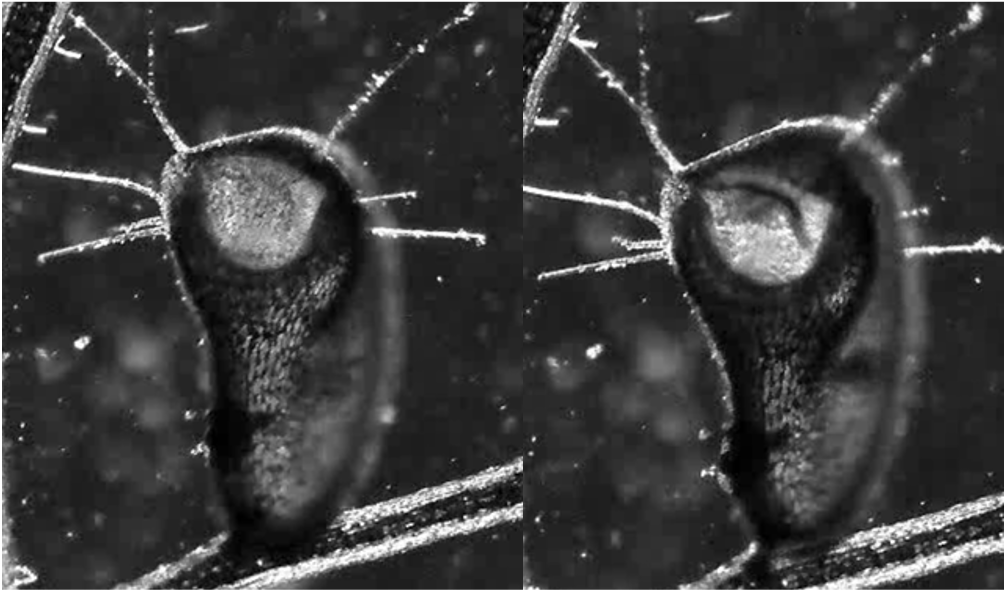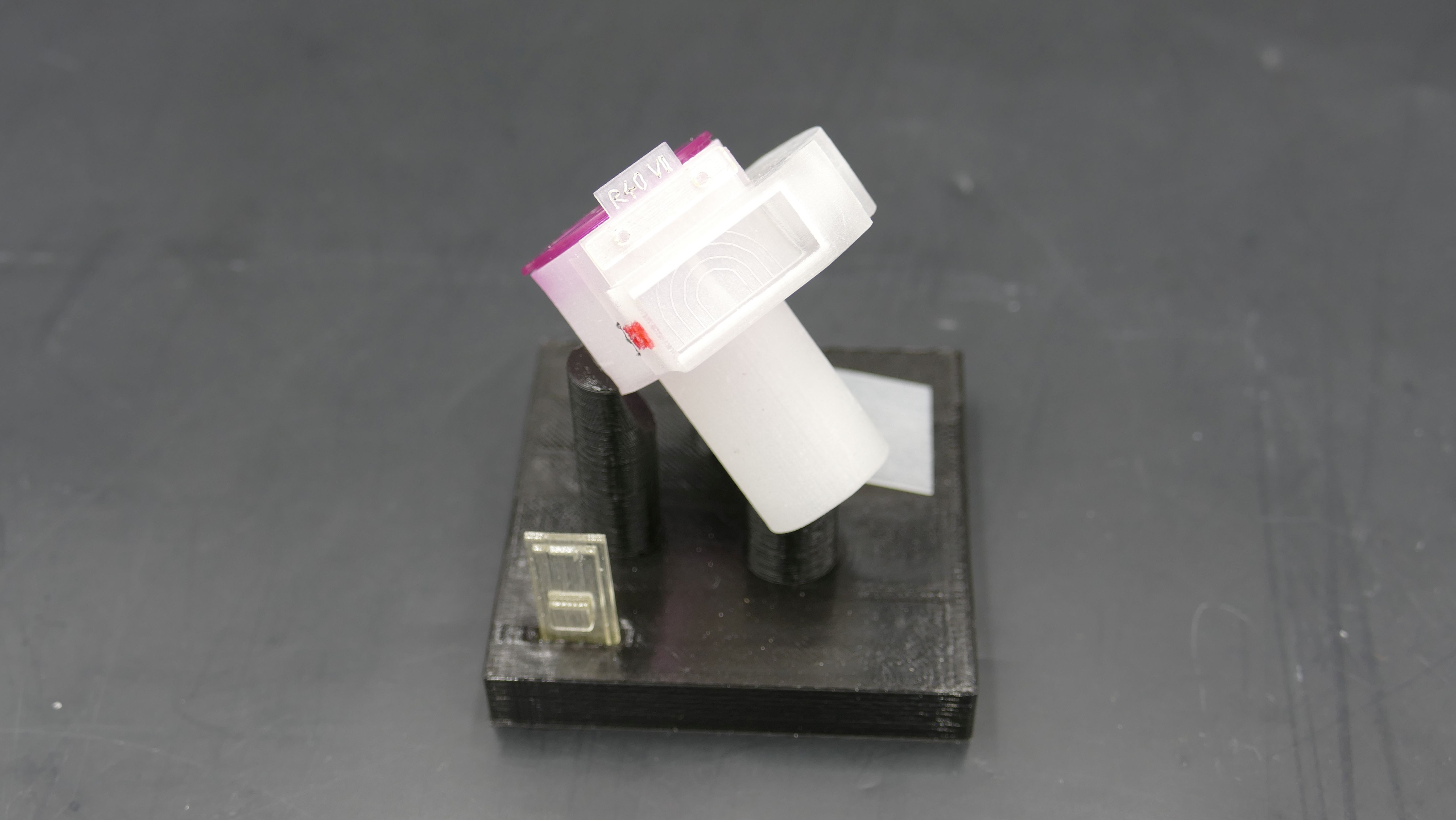Help for tracheostomy patients
Biomimetic speaking valve: how a carnivorous plant makes speaking safer
Nature is the best engineer, so they say, and it's always worth taking a closer look. An interdisciplinary group of researchers did just this and drew inspiration from an aquatic plant to develop a novel speaking valve for tracheostomy patients. At the University Medical Center Freiburg, Dr. Claudius Stahl and his team may have addressed a life-threatening issue that can arise in everyday clinical practice by creating a biomimetic valve with a warning signal.
For patients with a stoma (tracheostomy), a speaking valve is often an indispensable medical aid for verbal communication. It is a one-way valve that is placed on the ventilation tube to direct air into the lungs during inhalation. However, when the patient exhales, the valve blocks the airflow and forces the air to flow past the cannula through the upper airways and vocal cords. This not only enables patients to speak but also makes it easier to cough up mucus, which significantly reduces the risk of pneumonia.
Near-miss incidents are potentially fatal
However, this life-enhancing technology also carries risks: the small inner balloon, known as the cuff, which seals the connection between the tracheostomy tube and the windpipe, must be completely deflated before the valve is used. If this is overlooked, the patient will be unable to exhale. Any attempt to do so can lead to a dangerous build-up of pressure in the chest. Those affected report a feeling of suffocation, and in severe cases, the alveoli can burst in what is a life-threatening complication. Several years ago, following a number of deaths attributed to this operational error, the Federal Institute for Drugs and Medical Devices (BfArM) criticized the 'suitability for use' of the products and urged manufacturers to address the issue. Consequently, speaking valves labelled with warning colours were launched on the market.
The Critical Incident Reporting System (CIRS) at the University Medical Center Freiburg has repeatedly reported dangerous near-complications associated with the use of speaking valves, particularly in intensive care units. CIRS is an anonymous reporting system that enables staff to report critical incidents without fear of repercussion under labour law. Even speaking valves labelled with warning colours were unable to prevent these incidents. It became clear that the focus was not on individual errors but on a systematic deficiency in the speaking valves used up to that point. The need for a new technical solution was therefore evident, as CIRS representative Dr. Klaus Michael Lücking from the University Medical Center Freiburg points out.
Idea from the botanical garden
 Dr. Claudius Stahl is working with Dr. Klaus Michael Lücking, Noah Knorr, Dr. Falk Tauber and Prof. Dr. Thomas Speck to develop a biomimetic speaking valve for patients who have undergone a tracheostomy. © Dr. Claudius Stahl, private
Dr. Claudius Stahl is working with Dr. Klaus Michael Lücking, Noah Knorr, Dr. Falk Tauber and Prof. Dr. Thomas Speck to develop a biomimetic speaking valve for patients who have undergone a tracheostomy. © Dr. Claudius Stahl, privateDr. Claudius Stahl, a physician at the University Medical Center Freiburg, brought the problem to the attention of Prof. Dr. Thomas Speck, a bionics expert and head of the Freiburg Botanical Garden and the livMatS (Living, Adaptive and Energy-autonomous Materials Systems) cluster of excellence at the University of Freiburg. They found inspiration for a solution in an unexpected source: the bladderwort (Utricularia vulgaris). This carnivorous aquatic plant uses tiny bubbles to catch water fleas and other microorganisms. The bladders use a curved membrane known as a trapdoor to create underpressure inside and seal the opening to the outside. If an insect or other microorganism touches the hairs on the outside of the membrane, it snaps open, and, due to the underpressure, prey and water are sucked into the trap at lightning speed.
When Stahl described his problem, the livMatS team immediately recognised its potential. "I explained that I needed a kind of valve, and they immediately said, "This aquatic plant could be a smart solution to your medical issue," he recalls. Speck's team had been researching the trapping mechanism of the bladderwort for a long time and were finally able to envisage its direct application potential. An interdisciplinary team comprising master's student Noah Knorr, Dr. Falk Tauber, Speck, and Lücking, Stahl developed the prototype of the valve.
From underpressure to overpressure
 The bubbles of the aquatic plant Utricularia vulgaris served as a biological model for the team's new speaking valve. Left: Closed bubble; right: The membrane opens and sucks microorganisms inside. © Plant Biomechanics Group, Botanical Garden, University of Freiburg
The bubbles of the aquatic plant Utricularia vulgaris served as a biological model for the team's new speaking valve. Left: Closed bubble; right: The membrane opens and sucks microorganisms inside. © Plant Biomechanics Group, Botanical Garden, University of FreiburgHowever, transferring the biological principle to a technical application was no trivial matter, as the flow direction had to be reversed. While the plant creates underpressure to suck in water when the valve opens, the artificial valve had to respond to overpressure in order to open. "In an emergency, the membrane needs to open outwards rather than inwards," explains Stahl. "This is where we departed from the biological model and made the necessary abstraction."
The resulting prototype mimics the three-dimensionally curved membrane of the aquatic plant. The membrane seals the valve reliably and remains stable at normal speaking pressure. If the pressure in the lungs increases, for example, when exhaling or coughing, the membrane snaps open at a certain threshold, allowing the air to escape. The valve operates purely mechanically based on the all-or-nothing principle, which makes it particularly reliable when compared to electronic systems. This is also modelled after the plant, as its catching mechanism is purely mechanical and has no control mechanisms that are prone to failure. Another ingenious feature is the integration of a simple whistle that emits a loud signal when the valve opens, which alerts nursing staff.
Dual safety
 The innovative speaking valve was able to solve a life-threatening problem for tracheostomy patients. The movable membrane is visible directly behind the rectangular window and opens outwards when the pressure increases. © Plant Biomechanics Group, Botanical Garden, University of Freiburg
The innovative speaking valve was able to solve a life-threatening problem for tracheostomy patients. The movable membrane is visible directly behind the rectangular window and opens outwards when the pressure increases. © Plant Biomechanics Group, Botanical Garden, University of FreiburgHowever, a crucial aspect of bionic design is adaptability. The opening pressure of the valve can be precisely adjusted by modifying the thickness, curvature and length of the membrane. "The easiest way to change the pressure is to alter the membrane thickness," says Stahl. A thicker membrane requires more pressure to open. This flexibility is very important because speaking pressure varies among patients: an opera singer generates higher pressure than a typical adult or child. In the future, it may be possible to adapt the valve to the individual needs of patients.
The safety of the valve is based on a dual mechanism: mechanical pressure relief via the biomimetic membrane, which opens automatically in the event of excess pressure, thereby immediately eliminating any risk to the patient, and an acoustic warning signal - an integrated whistle triggered by the escaping air. The latter addresses the human component of the problem in a simple yet ingenious way. In most cases, the person who has attached the valve is still in the room when the error occurs. A silent error that might be overlooked is transformed into an unmistakable alarm signal. This acoustic signal alerts the nurse and enables the situation to be corrected quickly, making the process safer both technically and in terms of behavioural psychology.
Valuable interdisciplinary cooperation
This project is a prime example of a fruitful collaboration between different fields of medicine and bionics. The University of Freiburg has applied for a patent for the invention. Clinical trials are now planned to test the valve under real-life conditions and validate its expected contribution to patient safety. Stahl anticipates that further improvements will be made to the prototype before a finished product is created.
This clearly demonstrates the importance of interdisciplinary spaces where experts from different fields can come together. There was no commission for this project, and the findings surprised everyone involved. The project came about as the result of a lucky coincidence and the shared enjoyment of leveraging creative curiosity to solve a real-life problem. "We need many more spaces like this, where people from different disciplines can meet and develop new ideas," says Stahl.